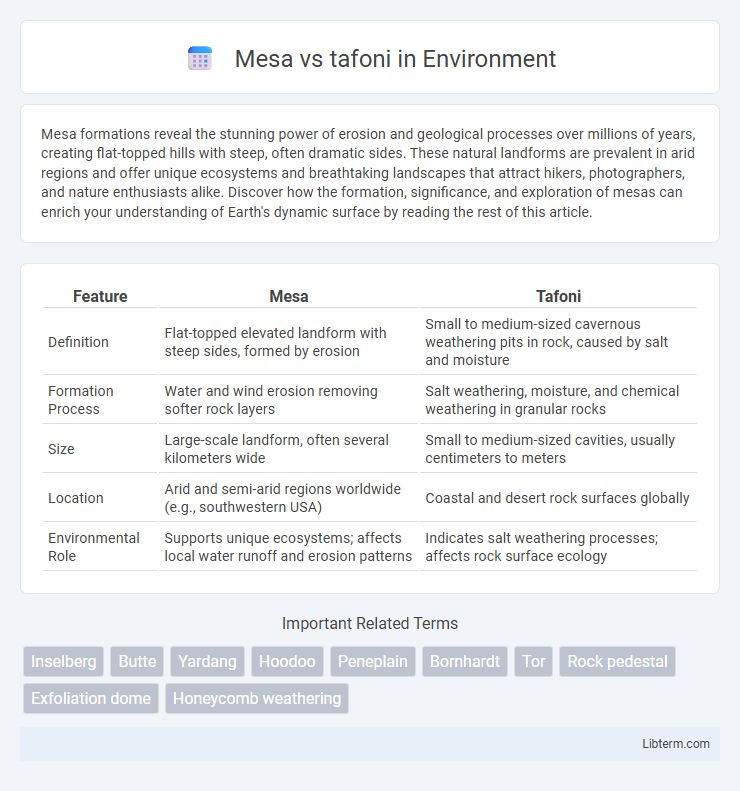Mesa formations reveal the stunning power of erosion and geological processes over millions of years, creating flat-topped hills with steep, often dramatic sides. These natural landforms are prevalent in arid regions and offer unique ecosystems and breathtaking landscapes that attract hikers, photographers, and nature enthusiasts alike. Discover how the formation, significance, and exploration of mesas can enrich your understanding of Earth's dynamic surface by reading the rest of this article.
Table of Comparison
| Feature | Mesa | Tafoni |
|---|---|---|
| Definition | Flat-topped elevated landform with steep sides, formed by erosion | Small to medium-sized cavernous weathering pits in rock, caused by salt and moisture |
| Formation Process | Water and wind erosion removing softer rock layers | Salt weathering, moisture, and chemical weathering in granular rocks |
| Size | Large-scale landform, often several kilometers wide | Small to medium-sized cavities, usually centimeters to meters |
| Location | Arid and semi-arid regions worldwide (e.g., southwestern USA) | Coastal and desert rock surfaces globally |
| Environmental Role | Supports unique ecosystems; affects local water runoff and erosion patterns | Indicates salt weathering processes; affects rock surface ecology |
Introduction to Mesa and Tafoni
Mesa refers to an elevated, flat-topped landform with steep sides, commonly found in arid or semi-arid regions, formed by erosion-resistant rock layers. Tafoni describes small cavernous weathering features on rock surfaces, characterized by rounded hollows or honeycomb patterns, typically resulting from salt weathering and moisture exposure. Both formations highlight distinct geological processes shaping landscapes through erosion and weathering.
Geological Definitions: Mesa vs Tafoni
A mesa is a flat-topped, elevated landform with steep sides formed by erosion-resistant rock layers, commonly found in arid regions and characterized by a horizontal stratigraphy. Tafoni are small, hollowed-out cavities or cave-like features that develop on rock surfaces due to weathering processes such as salt crystallization, typically appearing on granular rocks like sandstone or granite. While mesas represent large-scale geomorphological structures, tafoni are micro-scale weathering phenomena integral to rock surface evolution.
Formation Processes of Mesa
Mesa formation involves the erosion-resistant caprock protecting underlying softer rock layers, resulting in steep-sided, flat-topped landforms commonly found in arid regions. Wind and water erosion gradually wear away the surrounding softer sedimentary rock, isolating the mesa from adjacent terrain. In contrast, tafoni form through salt weathering and moisture-induced granular disintegration, producing small cavernous features primarily on rock surfaces rather than large-scale landforms.
Formation Processes of Tafoni
Tafoni formation primarily results from complex weathering processes involving salt crystallization, moisture cycling, and chemical dissolution on granular rock surfaces, particularly in coastal or arid environments. This weathering creates distinctive hollowed cavities within rock outcrops, differing from mesas that are large, flat-topped elevations formed by differential erosion and resistant caprock layers. Understanding tafoni formation provides key insights into micro-scale geomorphological changes driven by environmental factors such as salt spray, temperature fluctuations, and hydration-dehydration cycles.
Key Differences Between Mesa and Tafoni
Mesa formations are large, flat-topped hills with steep sides, typically found in arid landscapes and formed primarily through erosion and weathering of horizontal rock layers. Tafoni are small, hollowed-out rock features often found in coastal and desert environments, created by salt weathering and moisture cycles leading to cavity formation. The key difference lies in scale and formation processes: mesas are extensive landforms shaped by erosion over wide areas, while tafoni are localized, granular cavities formed by chemical and physical weathering.
Environmental Factors Influencing Mesa
Environmental factors influencing mesa formation include arid climates with limited precipitation, which reduce erosion rates and preserve the flat-topped structures. Wind erosion and temperature fluctuations cause mechanical weathering that shapes the mesa's steep sides. Resistant rock layers, such as sandstone, protect the mesa's caprock, while underlying softer materials erode more quickly, leading to the mesa's distinct flat summit contrasted with steep cliffs.
Environmental Factors Influencing Tafoni
Tafoni formation is primarily influenced by environmental factors such as salt weathering, moisture availability, and temperature fluctuations that facilitate granular disintegration and cavity development within rock surfaces. These processes differ from mesas, which are shaped mainly by erosion-resistant rock layers and extensive weathering over larger landforms. The microclimatic conditions around tafoni, including wind-blown salt spray and cyclic wetting and drying, create unique habitats that accelerate localized rock weathering distinct from the broader erosional dynamics observed in mesa landscapes.
Notable Locations of Mesa Around the World
Notable mesas such as the Grand Mesa in Colorado, USA, the Table Mountain in South Africa, and the Ischigualasto Provincial Park in Argentina showcase distinct flat-topped elevations formed by erosion-resistant rock layers. The Grand Mesa, one of the largest flat-topped mountains worldwide, features extensive basalt caprock, while Table Mountain's iconic flat summit is composed mainly of sandstone, offering unique ecological habitats. In contrast to tafoni, which are small-scale cavernous rock formations created by weathering, mesas represent large-scale geomorphological features dominating landscapes across arid and semi-arid regions globally.
Famous Examples of Tafoni Structures
Tafoni are distinctive geological formations characterized by honeycomb-like weathering patterns on rock surfaces, often found in coastal and desert environments. Famous examples of tafoni structures include the iconic formations at Elgol on the Isle of Skye in Scotland, the sandstone tafoni in Death Valley National Park, California, and the granite tafoni cliffs at Point Lobos State Natural Reserve in California. Unlike mesas, which are flat-topped, steep-sided landforms created primarily through erosion, tafoni result from salt weathering and moisture processes that create intricate cavities and pits in rock faces.
Ecological and Cultural Significance
Mesas and tafoni hold distinct ecological and cultural significance shaped by their unique formations and environments. Mesas, characterized by their flat-topped, elevated landforms, provide critical habitats for diverse plant and animal species adapted to arid climates, while also serving as sacred sites and landmarks in Indigenous cultures across the American Southwest. Tafoni, small cave-like weathering features found on rocky outcrops, contribute to microhabitat diversity by creating sheltered niches for specialized mosses, lichens, and invertebrates, and hold cultural value as natural symbols in Mediterranean and coastal Indigenous communities.
Mesa Infographic

 libterm.com
libterm.com